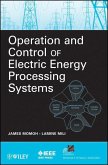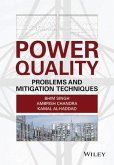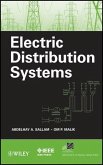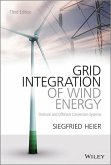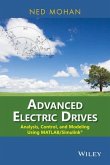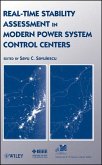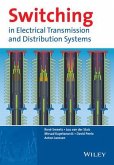Operation and Control of Electric Energy Processing Systems (eBook, ePUB)
Redaktion: Momoh, James A.; Mili, Lamine
89,99 €
89,99 €
inkl. MwSt.
Sofort per Download lieferbar

0 °P sammeln
89,99 €
Als Download kaufen

89,99 €
inkl. MwSt.
Sofort per Download lieferbar

0 °P sammeln
Jetzt verschenken
Alle Infos zum eBook verschenken
89,99 €
inkl. MwSt.
Sofort per Download lieferbar
Alle Infos zum eBook verschenken

0 °P sammeln
Operation and Control of Electric Energy Processing Systems (eBook, ePUB)
Redaktion: Momoh, James A.; Mili, Lamine
- Format: ePub
- Merkliste
- Auf die Merkliste
- Bewerten Bewerten
- Teilen
- Produkt teilen
- Produkterinnerung
- Produkterinnerung

Bitte loggen Sie sich zunächst in Ihr Kundenkonto ein oder registrieren Sie sich bei
bücher.de, um das eBook-Abo tolino select nutzen zu können.
Hier können Sie sich einloggen
Hier können Sie sich einloggen
Sie sind bereits eingeloggt. Klicken Sie auf 2. tolino select Abo, um fortzufahren.

Bitte loggen Sie sich zunächst in Ihr Kundenkonto ein oder registrieren Sie sich bei bücher.de, um das eBook-Abo tolino select nutzen zu können.
The purpose of this book is to provide a working knowledge and an exposure to cutting edge developments in operation and control of electric energy processing systems. The book focuses on the modeling and control of interdependent communications and electric energy systems, Micro-Electro-Mechanical Systems (MEMS), and the interdisciplinary education component of the EPNES initiative.
- Geräte: eReader
- mit Kopierschutz
- eBook Hilfe
- Größe: 7.37MB
Andere Kunden interessierten sich auch für
![Operation and Control of Electric Energy Processing Systems (eBook, PDF) Operation and Control of Electric Energy Processing Systems (eBook, PDF)]() Operation and Control of Electric Energy Processing Systems (eBook, PDF)89,99 €
Operation and Control of Electric Energy Processing Systems (eBook, PDF)89,99 €![Power Quality (eBook, ePUB) Power Quality (eBook, ePUB)]() Bhim SinghPower Quality (eBook, ePUB)105,99 €
Bhim SinghPower Quality (eBook, ePUB)105,99 €![Electric Distribution Systems (eBook, ePUB) Electric Distribution Systems (eBook, ePUB)]() Abdelhay A. SallamElectric Distribution Systems (eBook, ePUB)102,99 €
Abdelhay A. SallamElectric Distribution Systems (eBook, ePUB)102,99 €![Grid Integration of Wind Energy (eBook, ePUB) Grid Integration of Wind Energy (eBook, ePUB)]() Siegfried HeierGrid Integration of Wind Energy (eBook, ePUB)94,99 €
Siegfried HeierGrid Integration of Wind Energy (eBook, ePUB)94,99 €![Advanced Electric Drives (eBook, ePUB) Advanced Electric Drives (eBook, ePUB)]() Ned MohanAdvanced Electric Drives (eBook, ePUB)116,99 €
Ned MohanAdvanced Electric Drives (eBook, ePUB)116,99 €![Real-Time Stability Assessment in Modern Power System Control Centers (eBook, PDF) Real-Time Stability Assessment in Modern Power System Control Centers (eBook, PDF)]() S. C. SavulescuReal-Time Stability Assessment in Modern Power System Control Centers (eBook, PDF)131,99 €
S. C. SavulescuReal-Time Stability Assessment in Modern Power System Control Centers (eBook, PDF)131,99 €![Switching in Electrical Transmission and Distribution Systems (eBook, ePUB) Switching in Electrical Transmission and Distribution Systems (eBook, ePUB)]() René SmeetsSwitching in Electrical Transmission and Distribution Systems (eBook, ePUB)104,99 €
René SmeetsSwitching in Electrical Transmission and Distribution Systems (eBook, ePUB)104,99 €-
-
-
The purpose of this book is to provide a working knowledge and an exposure to cutting edge developments in operation and control of electric energy processing systems. The book focuses on the modeling and control of interdependent communications and electric energy systems, Micro-Electro-Mechanical Systems (MEMS), and the interdisciplinary education component of the EPNES initiative.
Dieser Download kann aus rechtlichen Gründen nur mit Rechnungsadresse in D ausgeliefert werden.
Produktdetails
- Produktdetails
- Verlag: John Wiley & Sons
- Erscheinungstermin: 4. November 2010
- Englisch
- ISBN-13: 9781118017104
- Artikelnr.: 37356762
- Verlag: John Wiley & Sons
- Erscheinungstermin: 4. November 2010
- Englisch
- ISBN-13: 9781118017104
- Artikelnr.: 37356762
- Herstellerkennzeichnung Die Herstellerinformationen sind derzeit nicht verfügbar.
James Momoh was chair of the Electrical Engineering Department at Howard University and director of the Center for Energy Systems and Control. In 1987, Momoh received a National Science Foundation (NSF) Presidential Young Investigator Award. He is a Fellow of the IEEE and a Distinguished Fellow of the Nigerian Society of Engineers (NSE). His current research activities for utility firms and government agencies span several areas in systems engineering, optimization, and energy systems' control of complex and dynamic networks. Lamine Mili is Professor of Electrical and Computer Engineering at Virginia Tech. An IEEE Senior Member, Dr. Mili is also a member of Institute of Mathematical Statistics and the American Statistical Association. His research interests include risk assessment and management of critical infrastructures; power system analysis and control; bifurcation theory and chaos; and robust statistics as applied to engineering problems.
Preface ix Contributors xi 1 A FRAMEWORK FOR INTERDISCIPLINARY RESEARCH AND EDUCATION 1 James Momoh 1.1 Introduction 1 1.2 Power System Challenges 4 1.2.1 The Power System Modeling and Computational Challenge 5 1.2.2 Modeling and Computational Techniques 6 1.2.3 New Interdisciplinary Curriculum for the Electric Power Network 6 1.3 Solution of the EPNES Architecture 6 1.3.1 Modular Description of the EPNES Architecture 6 1.3.2 Some Expectations of Studies Using EPNES Benchmark Test Beds 7 1.4 Test Beds for EPNES 8 1.4.1 Power System Model for the Navy 8 1.4.2 Civil Test Bed-179-Bus WSCC Benchmark Power System 10 1.5 Examples of Funded Research Work in Response to the EPNES Solicitation 10 1.5.1 Funded Research by Topical Areas/Groups under the EPNES Award 10 1.5.2 EPNES Award Distribution 12 1.6 Future Directions of EPNES 13 1.7 Conclusions 14 2 DYNAMICAL MODELS IN FAULT-TOLERANT OPERATION AND CONTROL OF ENERGY PROCESSING SYSTEMS 15 Christoforos N. Hadjicostis, Hugo Rodr
guez Cort
es, Aleksandar M. Stankovic 2.1 Introduction 15 2.2 Model-Based Fault Detection 16 2.2.1 Fault Detection via Analytic Redundancy 17 2.2.2 Failure Detection Filters 17 2.3 Detuning Detection and Accommodation on IFOC-Driven Induction Motors 19 2.3.1 Detuned Operation of Current-Fed Indirect Field-Oriented Controlled Induction Motors 20 2.3.2 Detection of the Detuned Operation 24 2.3.3 Estimation of the Magnetizing Flux 26 2.3.4 Accommodation of the Detuning Operation 27 2.3.5 Simulations 28 2.4 Broken Rotor Bar Detection on IFOC-Driven Induction Motors 28 2.4.1 Squirrel Cage Induction Motor Model with Broken Rotor Bars 29 2.4.2 Broken Rotor Bar Detection 31 2.5 Fault Detection on Power Systems 35 2.5.1 The Model 35 2.5.2 Class of Events 37 2.5.3 The Navy Electric Ship Example 38 2.5.4 Fault Detection Scheme 39 2.5.5 Numerical Simulations 41 2.6 Conclusions 43 3 INTELLIGENT POWER ROUTERS: DISTRIBUTED COORDINATION FOR ELECTRIC ENERGY PROCESSING NETWORKS 47 Agust
n A. Irizarry-Rivera, Manuel Rodr
guez-Mart
nez, Bienvenido V
elez, Miguel V
elez-Reyes, Alberto R. Ramirez-Orquin, Efrä
n O'Neill-Carrillo, Jos
e R. Cede
no 3.1 Introduction 47 3.2 Overview of the Intelligent Power Router Concept 48 3.3 IPR Architecture and Software Module 50 3.4 IPR Communication Protocols 55 3.4.1 State of the Art 55 3.4.2 Restoration of Electrical Energy Networks with IPRs 59 3.4.3 Mathematical Formulation 60 3.4.4 IPR Network Architecture 60 3.4.5 Islanding-Zone Approach via IPR 61 3.4.6 Negotiation in Two Phases 62 3.4.7 Experimental Results 65 3.5 Risk Assessment of a System Operating with IPR 65 3.5.1 IPR Components 65 3.5.2 Configuration 66 3.5.3 Example 66 3.6 Distributed Control Models 71 3.6.1 Distributed Control of Electronic Power Distribution Systems 71 3.6.2 Integrated Power System in Ship Architecture 74 3.6.3 DC Zonal Electric Distribution System 76 3.6.4 Implementation of the Reconfiguration Logic 77 3.6.5 Conclusion 77 3.7 Reconfiguration 79 3.8 Economics Issues of the Intelligent Power Router Service 79 3.8.1 The Standard Market Design (SMD) Environment 80 3.8.2 The Ancillary Service (A/S) Context 81 3.8.3 Reliability Aspects of Ancillary Services 81 3.8.4 The IPR Technical/Social/Economical Potential for Optimality 81 3.8.5 Proposed Definition for the Intelligent Power Router Ancillary Service 82 3.8.6 Summary 82 3.9 Conclusions 82 4 POWER CIRCUIT BREAKER USING MICROMECHANICAL SWITCHES 87 George G. Karady, Gerald T. Heydt, Esma Gel, Norma Hubele 4.1 Introduction 87 4.2 Overview of Technology 88 4.2.1 Medium Voltage Circuit Breaker 88 4.2.2 Micro-Electro-Mechanical Switches (MEMS) 90 4.3 The Concept of a MEMS-Based Circuit Breaker 92 4.3.1 Circuit Description 92 4.3.2 Operational Principle 93 4.3.3 Current Interruption 94 4.3.4 Switch Closing 94 4.4 Investigation of Switching Array Operation 95 4.4.1 Model Development 97 4.4.2 Analysis of Current Interruption and Load Energization 97 4.4.3 Effect of Delayed Opening of Switches 100 4.4.4 A Block of Switch Fails to Open 102 4.4.5 Effect of Delayed Closing of Switches 103 4.4.6 One Set of Switches Fails to Close 103 4.4.7 Summary of Simulation Results 104 4.5 Reliability Analyses 105 4.5.1 Approximations to Estimate Reliability 106 4.5.2 Computational Results 108 4.6 Proof of Principle Experiment 109 4.6.1 Circuit Breaker Construction 109 4.6.2 Control Circuit 111 4.7 Circuit Breaker Design 114 4.8 Conclusions 115 5 GIS-BASED SIMULATION STUDIES FOR POWER SYSTEMS EDUCATION 119 Ralph D. Badinelli, Virgilio Centeno, Boonyarit Intiyot 5.1 Overview 119 5.1.1 Case Studies 121 5.1.2 Generic Decision Model Structure 123 5.1.3 Simulation Modeling 126 5.1.4 Interfacing 130 5.2 Concepts for Modeling Power System Management and Control 133 5.2.1 Large-Scale Optimization and Hierarchical Planning 133 5.2.2 Sequential Decision Processes and Adaptation 137 5.2.3 Stochastic Decisions and Risk Modeling 140 5.2.4 Group Decision Making and Markets 141 5.2.5 Power System Simulation Objects 142 5.3 Grid Operation Models and Methods 143 5.3.1 Randomized Load Simulator 144 5.3.2 Market Maker 146 5.3.3 The Commitment Planner 150 5.3.4 Implementation 153 6 DISTRIBUTED GENERATION AND MOMENTUM CHANGE IN THE AMERICAN ELECTRIC UTILITY SYSTEM: A SOCIAL-SCIENCE SYSTEMS APPROACH 157 Richard F. Hirsh, Benjamin K. Sovacool, Ralph D. Badinelli 6.1 Introduction 157 6.2 Overview of Concepts 158 6.2.1 Using the Systems Approach to Understand Change in the Utility System 158 6.2.2 Origins and Growth of Momentum in the Electric Utility System 159 6.2.3 Politics and System Momentum Change 161 6.3 Application of Principles 163 6.3.1 The Possibility of Distributed Generation and New Momentum 164 6.3.2 Impediments to Decentralized Electricity Generation 166 6.4 Practical Consequences: Distributed Generation as a Business Enterprise 168 6.5 Aggregated Dispatch as a Means to Stimulate Economic Momentum with DG 170 6.6 Conclusion 172
guez Cort
es, Aleksandar M. Stankovic 2.1 Introduction 15 2.2 Model-Based Fault Detection 16 2.2.1 Fault Detection via Analytic Redundancy 17 2.2.2 Failure Detection Filters 17 2.3 Detuning Detection and Accommodation on IFOC-Driven Induction Motors 19 2.3.1 Detuned Operation of Current-Fed Indirect Field-Oriented Controlled Induction Motors 20 2.3.2 Detection of the Detuned Operation 24 2.3.3 Estimation of the Magnetizing Flux 26 2.3.4 Accommodation of the Detuning Operation 27 2.3.5 Simulations 28 2.4 Broken Rotor Bar Detection on IFOC-Driven Induction Motors 28 2.4.1 Squirrel Cage Induction Motor Model with Broken Rotor Bars 29 2.4.2 Broken Rotor Bar Detection 31 2.5 Fault Detection on Power Systems 35 2.5.1 The Model 35 2.5.2 Class of Events 37 2.5.3 The Navy Electric Ship Example 38 2.5.4 Fault Detection Scheme 39 2.5.5 Numerical Simulations 41 2.6 Conclusions 43 3 INTELLIGENT POWER ROUTERS: DISTRIBUTED COORDINATION FOR ELECTRIC ENERGY PROCESSING NETWORKS 47 Agust
n A. Irizarry-Rivera, Manuel Rodr
guez-Mart
nez, Bienvenido V
elez, Miguel V
elez-Reyes, Alberto R. Ramirez-Orquin, Efrä
n O'Neill-Carrillo, Jos
e R. Cede
no 3.1 Introduction 47 3.2 Overview of the Intelligent Power Router Concept 48 3.3 IPR Architecture and Software Module 50 3.4 IPR Communication Protocols 55 3.4.1 State of the Art 55 3.4.2 Restoration of Electrical Energy Networks with IPRs 59 3.4.3 Mathematical Formulation 60 3.4.4 IPR Network Architecture 60 3.4.5 Islanding-Zone Approach via IPR 61 3.4.6 Negotiation in Two Phases 62 3.4.7 Experimental Results 65 3.5 Risk Assessment of a System Operating with IPR 65 3.5.1 IPR Components 65 3.5.2 Configuration 66 3.5.3 Example 66 3.6 Distributed Control Models 71 3.6.1 Distributed Control of Electronic Power Distribution Systems 71 3.6.2 Integrated Power System in Ship Architecture 74 3.6.3 DC Zonal Electric Distribution System 76 3.6.4 Implementation of the Reconfiguration Logic 77 3.6.5 Conclusion 77 3.7 Reconfiguration 79 3.8 Economics Issues of the Intelligent Power Router Service 79 3.8.1 The Standard Market Design (SMD) Environment 80 3.8.2 The Ancillary Service (A/S) Context 81 3.8.3 Reliability Aspects of Ancillary Services 81 3.8.4 The IPR Technical/Social/Economical Potential for Optimality 81 3.8.5 Proposed Definition for the Intelligent Power Router Ancillary Service 82 3.8.6 Summary 82 3.9 Conclusions 82 4 POWER CIRCUIT BREAKER USING MICROMECHANICAL SWITCHES 87 George G. Karady, Gerald T. Heydt, Esma Gel, Norma Hubele 4.1 Introduction 87 4.2 Overview of Technology 88 4.2.1 Medium Voltage Circuit Breaker 88 4.2.2 Micro-Electro-Mechanical Switches (MEMS) 90 4.3 The Concept of a MEMS-Based Circuit Breaker 92 4.3.1 Circuit Description 92 4.3.2 Operational Principle 93 4.3.3 Current Interruption 94 4.3.4 Switch Closing 94 4.4 Investigation of Switching Array Operation 95 4.4.1 Model Development 97 4.4.2 Analysis of Current Interruption and Load Energization 97 4.4.3 Effect of Delayed Opening of Switches 100 4.4.4 A Block of Switch Fails to Open 102 4.4.5 Effect of Delayed Closing of Switches 103 4.4.6 One Set of Switches Fails to Close 103 4.4.7 Summary of Simulation Results 104 4.5 Reliability Analyses 105 4.5.1 Approximations to Estimate Reliability 106 4.5.2 Computational Results 108 4.6 Proof of Principle Experiment 109 4.6.1 Circuit Breaker Construction 109 4.6.2 Control Circuit 111 4.7 Circuit Breaker Design 114 4.8 Conclusions 115 5 GIS-BASED SIMULATION STUDIES FOR POWER SYSTEMS EDUCATION 119 Ralph D. Badinelli, Virgilio Centeno, Boonyarit Intiyot 5.1 Overview 119 5.1.1 Case Studies 121 5.1.2 Generic Decision Model Structure 123 5.1.3 Simulation Modeling 126 5.1.4 Interfacing 130 5.2 Concepts for Modeling Power System Management and Control 133 5.2.1 Large-Scale Optimization and Hierarchical Planning 133 5.2.2 Sequential Decision Processes and Adaptation 137 5.2.3 Stochastic Decisions and Risk Modeling 140 5.2.4 Group Decision Making and Markets 141 5.2.5 Power System Simulation Objects 142 5.3 Grid Operation Models and Methods 143 5.3.1 Randomized Load Simulator 144 5.3.2 Market Maker 146 5.3.3 The Commitment Planner 150 5.3.4 Implementation 153 6 DISTRIBUTED GENERATION AND MOMENTUM CHANGE IN THE AMERICAN ELECTRIC UTILITY SYSTEM: A SOCIAL-SCIENCE SYSTEMS APPROACH 157 Richard F. Hirsh, Benjamin K. Sovacool, Ralph D. Badinelli 6.1 Introduction 157 6.2 Overview of Concepts 158 6.2.1 Using the Systems Approach to Understand Change in the Utility System 158 6.2.2 Origins and Growth of Momentum in the Electric Utility System 159 6.2.3 Politics and System Momentum Change 161 6.3 Application of Principles 163 6.3.1 The Possibility of Distributed Generation and New Momentum 164 6.3.2 Impediments to Decentralized Electricity Generation 166 6.4 Practical Consequences: Distributed Generation as a Business Enterprise 168 6.5 Aggregated Dispatch as a Means to Stimulate Economic Momentum with DG 170 6.6 Conclusion 172
Preface ix Contributors xi 1 A FRAMEWORK FOR INTERDISCIPLINARY RESEARCH AND EDUCATION 1 James Momoh 1.1 Introduction 1 1.2 Power System Challenges 4 1.2.1 The Power System Modeling and Computational Challenge 5 1.2.2 Modeling and Computational Techniques 6 1.2.3 New Interdisciplinary Curriculum for the Electric Power Network 6 1.3 Solution of the EPNES Architecture 6 1.3.1 Modular Description of the EPNES Architecture 6 1.3.2 Some Expectations of Studies Using EPNES Benchmark Test Beds 7 1.4 Test Beds for EPNES 8 1.4.1 Power System Model for the Navy 8 1.4.2 Civil Test Bed-179-Bus WSCC Benchmark Power System 10 1.5 Examples of Funded Research Work in Response to the EPNES Solicitation 10 1.5.1 Funded Research by Topical Areas/Groups under the EPNES Award 10 1.5.2 EPNES Award Distribution 12 1.6 Future Directions of EPNES 13 1.7 Conclusions 14 2 DYNAMICAL MODELS IN FAULT-TOLERANT OPERATION AND CONTROL OF ENERGY PROCESSING SYSTEMS 15 Christoforos N. Hadjicostis, Hugo Rodr
guez Cort
es, Aleksandar M. Stankovic 2.1 Introduction 15 2.2 Model-Based Fault Detection 16 2.2.1 Fault Detection via Analytic Redundancy 17 2.2.2 Failure Detection Filters 17 2.3 Detuning Detection and Accommodation on IFOC-Driven Induction Motors 19 2.3.1 Detuned Operation of Current-Fed Indirect Field-Oriented Controlled Induction Motors 20 2.3.2 Detection of the Detuned Operation 24 2.3.3 Estimation of the Magnetizing Flux 26 2.3.4 Accommodation of the Detuning Operation 27 2.3.5 Simulations 28 2.4 Broken Rotor Bar Detection on IFOC-Driven Induction Motors 28 2.4.1 Squirrel Cage Induction Motor Model with Broken Rotor Bars 29 2.4.2 Broken Rotor Bar Detection 31 2.5 Fault Detection on Power Systems 35 2.5.1 The Model 35 2.5.2 Class of Events 37 2.5.3 The Navy Electric Ship Example 38 2.5.4 Fault Detection Scheme 39 2.5.5 Numerical Simulations 41 2.6 Conclusions 43 3 INTELLIGENT POWER ROUTERS: DISTRIBUTED COORDINATION FOR ELECTRIC ENERGY PROCESSING NETWORKS 47 Agust
n A. Irizarry-Rivera, Manuel Rodr
guez-Mart
nez, Bienvenido V
elez, Miguel V
elez-Reyes, Alberto R. Ramirez-Orquin, Efrä
n O'Neill-Carrillo, Jos
e R. Cede
no 3.1 Introduction 47 3.2 Overview of the Intelligent Power Router Concept 48 3.3 IPR Architecture and Software Module 50 3.4 IPR Communication Protocols 55 3.4.1 State of the Art 55 3.4.2 Restoration of Electrical Energy Networks with IPRs 59 3.4.3 Mathematical Formulation 60 3.4.4 IPR Network Architecture 60 3.4.5 Islanding-Zone Approach via IPR 61 3.4.6 Negotiation in Two Phases 62 3.4.7 Experimental Results 65 3.5 Risk Assessment of a System Operating with IPR 65 3.5.1 IPR Components 65 3.5.2 Configuration 66 3.5.3 Example 66 3.6 Distributed Control Models 71 3.6.1 Distributed Control of Electronic Power Distribution Systems 71 3.6.2 Integrated Power System in Ship Architecture 74 3.6.3 DC Zonal Electric Distribution System 76 3.6.4 Implementation of the Reconfiguration Logic 77 3.6.5 Conclusion 77 3.7 Reconfiguration 79 3.8 Economics Issues of the Intelligent Power Router Service 79 3.8.1 The Standard Market Design (SMD) Environment 80 3.8.2 The Ancillary Service (A/S) Context 81 3.8.3 Reliability Aspects of Ancillary Services 81 3.8.4 The IPR Technical/Social/Economical Potential for Optimality 81 3.8.5 Proposed Definition for the Intelligent Power Router Ancillary Service 82 3.8.6 Summary 82 3.9 Conclusions 82 4 POWER CIRCUIT BREAKER USING MICROMECHANICAL SWITCHES 87 George G. Karady, Gerald T. Heydt, Esma Gel, Norma Hubele 4.1 Introduction 87 4.2 Overview of Technology 88 4.2.1 Medium Voltage Circuit Breaker 88 4.2.2 Micro-Electro-Mechanical Switches (MEMS) 90 4.3 The Concept of a MEMS-Based Circuit Breaker 92 4.3.1 Circuit Description 92 4.3.2 Operational Principle 93 4.3.3 Current Interruption 94 4.3.4 Switch Closing 94 4.4 Investigation of Switching Array Operation 95 4.4.1 Model Development 97 4.4.2 Analysis of Current Interruption and Load Energization 97 4.4.3 Effect of Delayed Opening of Switches 100 4.4.4 A Block of Switch Fails to Open 102 4.4.5 Effect of Delayed Closing of Switches 103 4.4.6 One Set of Switches Fails to Close 103 4.4.7 Summary of Simulation Results 104 4.5 Reliability Analyses 105 4.5.1 Approximations to Estimate Reliability 106 4.5.2 Computational Results 108 4.6 Proof of Principle Experiment 109 4.6.1 Circuit Breaker Construction 109 4.6.2 Control Circuit 111 4.7 Circuit Breaker Design 114 4.8 Conclusions 115 5 GIS-BASED SIMULATION STUDIES FOR POWER SYSTEMS EDUCATION 119 Ralph D. Badinelli, Virgilio Centeno, Boonyarit Intiyot 5.1 Overview 119 5.1.1 Case Studies 121 5.1.2 Generic Decision Model Structure 123 5.1.3 Simulation Modeling 126 5.1.4 Interfacing 130 5.2 Concepts for Modeling Power System Management and Control 133 5.2.1 Large-Scale Optimization and Hierarchical Planning 133 5.2.2 Sequential Decision Processes and Adaptation 137 5.2.3 Stochastic Decisions and Risk Modeling 140 5.2.4 Group Decision Making and Markets 141 5.2.5 Power System Simulation Objects 142 5.3 Grid Operation Models and Methods 143 5.3.1 Randomized Load Simulator 144 5.3.2 Market Maker 146 5.3.3 The Commitment Planner 150 5.3.4 Implementation 153 6 DISTRIBUTED GENERATION AND MOMENTUM CHANGE IN THE AMERICAN ELECTRIC UTILITY SYSTEM: A SOCIAL-SCIENCE SYSTEMS APPROACH 157 Richard F. Hirsh, Benjamin K. Sovacool, Ralph D. Badinelli 6.1 Introduction 157 6.2 Overview of Concepts 158 6.2.1 Using the Systems Approach to Understand Change in the Utility System 158 6.2.2 Origins and Growth of Momentum in the Electric Utility System 159 6.2.3 Politics and System Momentum Change 161 6.3 Application of Principles 163 6.3.1 The Possibility of Distributed Generation and New Momentum 164 6.3.2 Impediments to Decentralized Electricity Generation 166 6.4 Practical Consequences: Distributed Generation as a Business Enterprise 168 6.5 Aggregated Dispatch as a Means to Stimulate Economic Momentum with DG 170 6.6 Conclusion 172
guez Cort
es, Aleksandar M. Stankovic 2.1 Introduction 15 2.2 Model-Based Fault Detection 16 2.2.1 Fault Detection via Analytic Redundancy 17 2.2.2 Failure Detection Filters 17 2.3 Detuning Detection and Accommodation on IFOC-Driven Induction Motors 19 2.3.1 Detuned Operation of Current-Fed Indirect Field-Oriented Controlled Induction Motors 20 2.3.2 Detection of the Detuned Operation 24 2.3.3 Estimation of the Magnetizing Flux 26 2.3.4 Accommodation of the Detuning Operation 27 2.3.5 Simulations 28 2.4 Broken Rotor Bar Detection on IFOC-Driven Induction Motors 28 2.4.1 Squirrel Cage Induction Motor Model with Broken Rotor Bars 29 2.4.2 Broken Rotor Bar Detection 31 2.5 Fault Detection on Power Systems 35 2.5.1 The Model 35 2.5.2 Class of Events 37 2.5.3 The Navy Electric Ship Example 38 2.5.4 Fault Detection Scheme 39 2.5.5 Numerical Simulations 41 2.6 Conclusions 43 3 INTELLIGENT POWER ROUTERS: DISTRIBUTED COORDINATION FOR ELECTRIC ENERGY PROCESSING NETWORKS 47 Agust
n A. Irizarry-Rivera, Manuel Rodr
guez-Mart
nez, Bienvenido V
elez, Miguel V
elez-Reyes, Alberto R. Ramirez-Orquin, Efrä
n O'Neill-Carrillo, Jos
e R. Cede
no 3.1 Introduction 47 3.2 Overview of the Intelligent Power Router Concept 48 3.3 IPR Architecture and Software Module 50 3.4 IPR Communication Protocols 55 3.4.1 State of the Art 55 3.4.2 Restoration of Electrical Energy Networks with IPRs 59 3.4.3 Mathematical Formulation 60 3.4.4 IPR Network Architecture 60 3.4.5 Islanding-Zone Approach via IPR 61 3.4.6 Negotiation in Two Phases 62 3.4.7 Experimental Results 65 3.5 Risk Assessment of a System Operating with IPR 65 3.5.1 IPR Components 65 3.5.2 Configuration 66 3.5.3 Example 66 3.6 Distributed Control Models 71 3.6.1 Distributed Control of Electronic Power Distribution Systems 71 3.6.2 Integrated Power System in Ship Architecture 74 3.6.3 DC Zonal Electric Distribution System 76 3.6.4 Implementation of the Reconfiguration Logic 77 3.6.5 Conclusion 77 3.7 Reconfiguration 79 3.8 Economics Issues of the Intelligent Power Router Service 79 3.8.1 The Standard Market Design (SMD) Environment 80 3.8.2 The Ancillary Service (A/S) Context 81 3.8.3 Reliability Aspects of Ancillary Services 81 3.8.4 The IPR Technical/Social/Economical Potential for Optimality 81 3.8.5 Proposed Definition for the Intelligent Power Router Ancillary Service 82 3.8.6 Summary 82 3.9 Conclusions 82 4 POWER CIRCUIT BREAKER USING MICROMECHANICAL SWITCHES 87 George G. Karady, Gerald T. Heydt, Esma Gel, Norma Hubele 4.1 Introduction 87 4.2 Overview of Technology 88 4.2.1 Medium Voltage Circuit Breaker 88 4.2.2 Micro-Electro-Mechanical Switches (MEMS) 90 4.3 The Concept of a MEMS-Based Circuit Breaker 92 4.3.1 Circuit Description 92 4.3.2 Operational Principle 93 4.3.3 Current Interruption 94 4.3.4 Switch Closing 94 4.4 Investigation of Switching Array Operation 95 4.4.1 Model Development 97 4.4.2 Analysis of Current Interruption and Load Energization 97 4.4.3 Effect of Delayed Opening of Switches 100 4.4.4 A Block of Switch Fails to Open 102 4.4.5 Effect of Delayed Closing of Switches 103 4.4.6 One Set of Switches Fails to Close 103 4.4.7 Summary of Simulation Results 104 4.5 Reliability Analyses 105 4.5.1 Approximations to Estimate Reliability 106 4.5.2 Computational Results 108 4.6 Proof of Principle Experiment 109 4.6.1 Circuit Breaker Construction 109 4.6.2 Control Circuit 111 4.7 Circuit Breaker Design 114 4.8 Conclusions 115 5 GIS-BASED SIMULATION STUDIES FOR POWER SYSTEMS EDUCATION 119 Ralph D. Badinelli, Virgilio Centeno, Boonyarit Intiyot 5.1 Overview 119 5.1.1 Case Studies 121 5.1.2 Generic Decision Model Structure 123 5.1.3 Simulation Modeling 126 5.1.4 Interfacing 130 5.2 Concepts for Modeling Power System Management and Control 133 5.2.1 Large-Scale Optimization and Hierarchical Planning 133 5.2.2 Sequential Decision Processes and Adaptation 137 5.2.3 Stochastic Decisions and Risk Modeling 140 5.2.4 Group Decision Making and Markets 141 5.2.5 Power System Simulation Objects 142 5.3 Grid Operation Models and Methods 143 5.3.1 Randomized Load Simulator 144 5.3.2 Market Maker 146 5.3.3 The Commitment Planner 150 5.3.4 Implementation 153 6 DISTRIBUTED GENERATION AND MOMENTUM CHANGE IN THE AMERICAN ELECTRIC UTILITY SYSTEM: A SOCIAL-SCIENCE SYSTEMS APPROACH 157 Richard F. Hirsh, Benjamin K. Sovacool, Ralph D. Badinelli 6.1 Introduction 157 6.2 Overview of Concepts 158 6.2.1 Using the Systems Approach to Understand Change in the Utility System 158 6.2.2 Origins and Growth of Momentum in the Electric Utility System 159 6.2.3 Politics and System Momentum Change 161 6.3 Application of Principles 163 6.3.1 The Possibility of Distributed Generation and New Momentum 164 6.3.2 Impediments to Decentralized Electricity Generation 166 6.4 Practical Consequences: Distributed Generation as a Business Enterprise 168 6.5 Aggregated Dispatch as a Means to Stimulate Economic Momentum with DG 170 6.6 Conclusion 172

